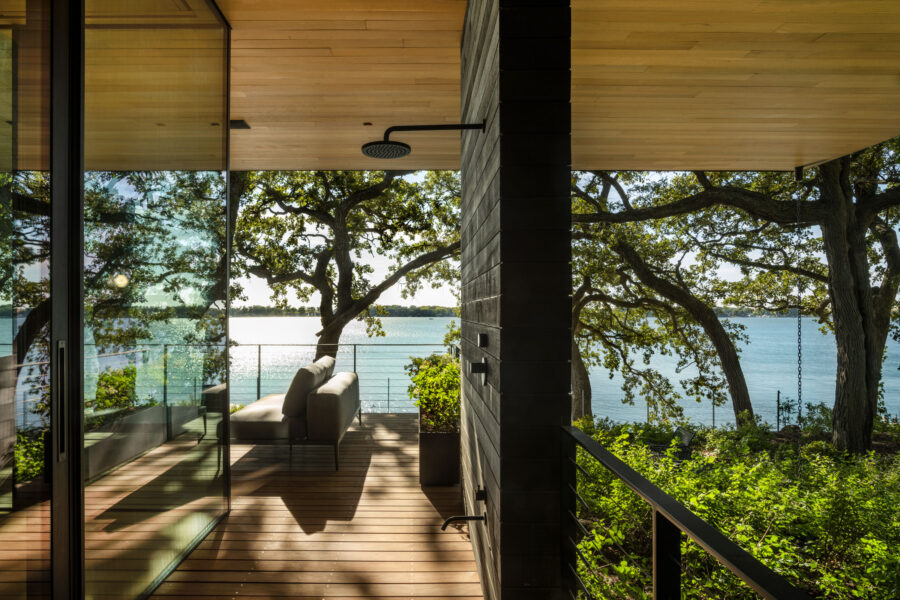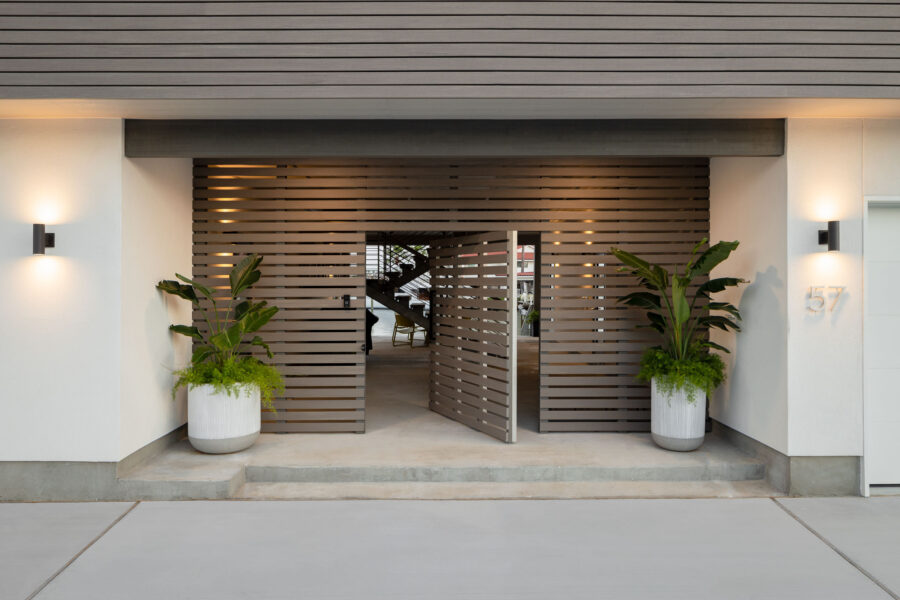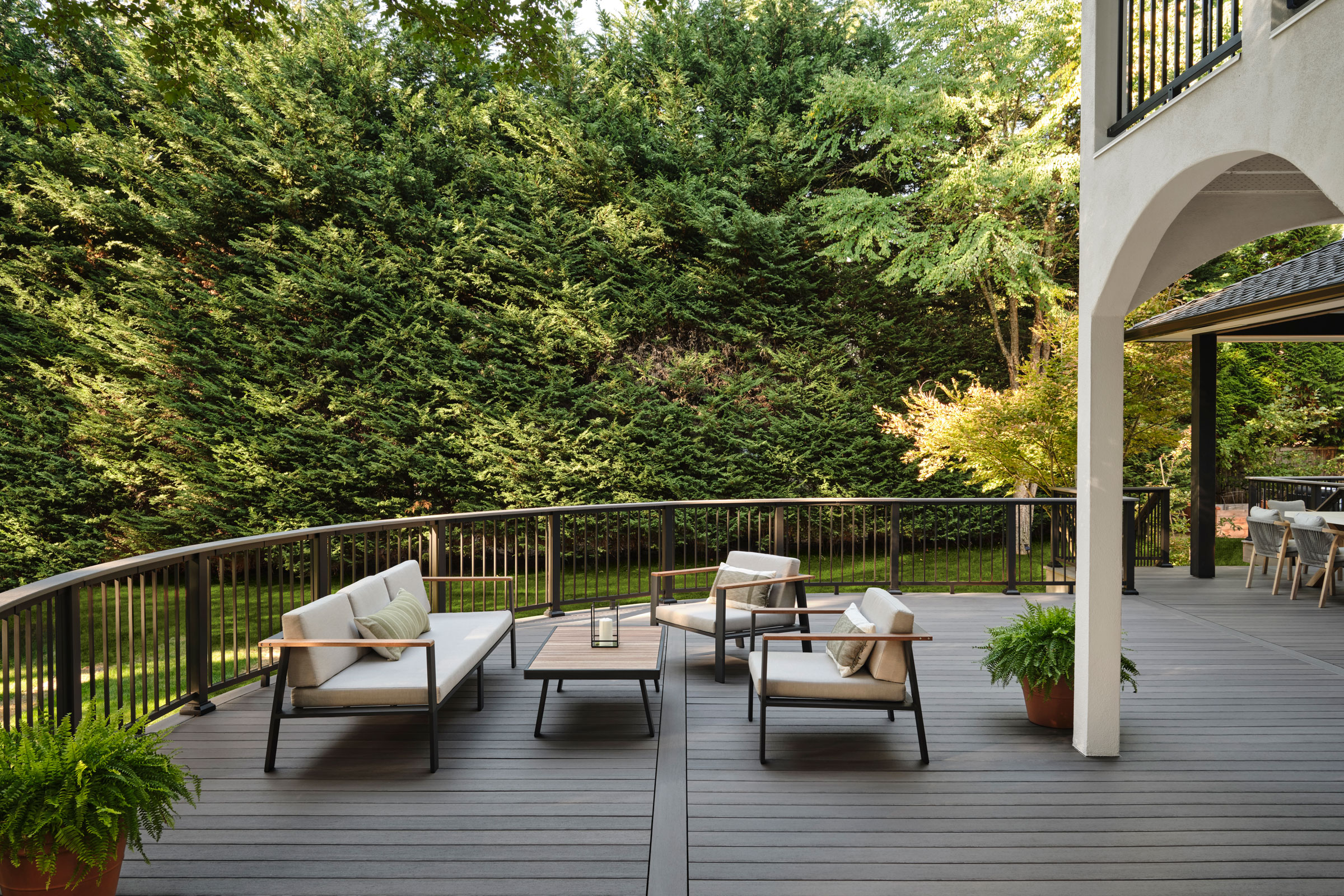Story at a glance:
- Homeowner preferences for outdoor living spaces that transition seamlessly from their interiors is driving innovation in design and decking materials.
- Applications subject to extreme temperatures, high humidity, and other environmental stresses can often benefit from alternatives to natural woods.
- Decking products that incorporate recycled plastics offer a range of design options and superior performance, as well as a sustainable carbon profile.
Outdoor living is getting a lot more integrated into the everyday as the same level of attention around interior design is moving into outdoor spaces. Homeowners are finding new ways to get their outdoor spaces to flow almost seamlessly from their homes, opening their residences to the surrounding landscape while taking advantage of flexible, useful space.
Even in cold climates homeowners like to spend time outdoors, says Ray Calabro, a principal in the Seattle studio of Bohlin Cywinski Jackson (BCJ). “There’s a desire for fresh air,” he says. “There’s a desire to feel immersed a little more in the weather. And I think there’s a desire for people to want to gather together outdoors in spaces that feel comfortable.”
Depending on the client that might mean adding amenities like heat and ventilation, an outdoor shower, hot tub, grill, or bar to a deck or patio. Whatever shape the outdoor space takes, people are looking for the flexibility to entertain guests, read, dine, exercise, and relax just steps from their interiors.
“Spaces might have something like a firepit or a built-in cocktail bar—something that allows them to enjoy the view or the place a little bit more,” Calabro says. “Maybe it’s a fireplace, maybe the deck is covered but open to the view. Maybe there’s a heated floor or heaters in the soffits. You can do any number of things to mitigate some of the extremes and make places more comfortable for people.”
While outdoor living has never gone out of style, pandemic lockdowns encouraged people to reassess their spaces, expanding the concept of home to fresh air settings. “The outdoors was seen as the only safe way to connect,” Calabro says. “People decided to use their outdoor spaces in different ways. That was a huge leap forward.”
Framing the Landscape

Indoor areas transition seamlessly to an expansive outdoor terrace protected by a dramatic roof overhang at the Highbank Residence, designed by Bohlin Cywinski Jackson (BCJ). Photo by Nic Lehoux
Serving residential clients in locations of natural beauty, Calabro and BCJ strive to design spaces that present minimal visual barriers to the surrounding landscape. “We’re trying to kind of dissolve the envelope of the house a little bit,” he says. “A trend seems to be spaces that blur the boundary between indoors and out. The materials used on the exterior and on the interior draw your eye out with as little interruption as possible.”
A trend seems to be spaces that blur the boundary between indoors and out.
A guesthouse Calabro designed in the San Juan Islands, for example, features a central living room/kitchenette that opens to the outdoors on two sides. Depending on the weather, the occupants can keep the wide glass pocket doors closed, leave only screens in place, or open the home completely. “We’re trying to make a place that feels calm and static-free.”
What makes a great outdoor space? “For me it’s a sense of calm,” Calabro says. “Immersion in the outdoors is about trying to become a little more connected to your surroundings. It gives you a feeling that you are given a perch or a view that maybe no one else has.”
Not Your Parents’ Decking

AZEK’s Evolutions Rail is seen here in weathered teak. Photo courtesy of TimberTech
Natural woods aren’t always up to the task when it comes to temperature extremes or high-humidity applications, however. Calabro specified thermally modified woods for a pool deck in one high-end home and says many West Coast clients are asking about fire-resistant composites for their home exteriors.
Even in relatively predictable climates, wood decking requires considerable maintenance and upkeep as well as periodic replacement. Architects and homeowners familiar with early versions of recycled composite decking materials may remember them looking, well, not so beautiful, but that’s not how they are now.
“The aesthetics have come a long way,” says Amanda Cimaglia, vice president of corporate communications and ESG for TimberTech, part of parent company The AZEK Company, a building products manufacturer headquartered in Chicago with operations across the US. “TimberTech’s decking materials are almost indistinguishable from real wood.”
So far only about one-quarter of decks in the US are made from composites, she says, but residential projects are increasingly turning to the manufactured alternatives. TimberTech is building awareness by tapping influencers like HGTV’s Married to Real Estate hosts Egypt Sherrod and Mike Jackson.
“Homeowners, architects, and designers don’t have to trade off on aesthetics to get performance and durability,” Cimaglia says. “That’s what’s helping us convert the market away from traditional wood applications that require a lot of maintenance and are less sustainable.”
Why Consider Composite?

Photo courtesy of TimberTech
TimberTech offers two decking lines that mimic the look and feel of real wood, albeit without the knots, splinters, and loose screws. Durable and sustainable, they “allow homeowners to live their best lives outdoors,” Cimaglia says.
TimberTech Composite Decking by AZEK contains approximately 85% recycled material, a combination of high-density polyethylene (think laundry detergent bottles) and low-density polyethylene (the typical grocery store bag). These are shredded and combined with reclaimed wood flour, then encased in a protective layer of virgin polyethylene.
TimberTech Advanced PVC Decking by AZEK incorporates about 60% rigid recycled PVC from castoff flooring, siding, and piping products. Together the lines offer 35 colors and multiple textures, mimicking everything from elm to oak to walnut.
Homeowners looking for that seamless indoor/outdoor flow have options. “If they have light, airy oak floors on the interior of the home, they want to transition that aesthetic to their outdoor living space,” Cimaglia says. “If they’ve got darker rich walnuts inside, they want to be able to carry that to their outdoor living spaces as well.”
Weathered looks are currently popular, but preferences vary. “From a design perspective it’s unique to the homeowner,” Cimaglia says. “What I might like in my home might be different from what you might like in your home. But the great thing is the breadth and depth of our portfolio matches any design desire or aesthetic.”
Matching the Looks of Real Wood
For TimberTech the aesthetics are more crucial than ever. While older composites often had an exaggerated, almost cartoonish wood grain look with one or two base colors and a repeated faux grain, TimberTech delivers a more nuanced product that looks as elegant as real wood.
For nearly a decade TimberTech has designed its composite and PVC decking lines to mimic specific woods like stained ipe, mahogany, and reclaimed wood. Pigments are blended to deliver the rich spectrum of coloration seen in natural wood, and capstock finishes are refined to eliminate repeated patterns in the grain; like real wood, no two boards are identical.
As a result architects and designers no longer need to worry that composite decking materials won’t meet the aesthetic demands of high-end homes. TimberTech’s decking is almost indistinguishable from real wood—but with better performance and longevity.
A Sustainable Life Cycle
TimberTech’s R&D has successfully increased the amount of recycled material used in its products without impacting their design profile, diverting more than 2.1 billion pounds of waste and scrap from landfills in the last few years since 2019. “We have a goal of using 1 billion pounds of recycled material annually to manufacture our products,” Cimaglia says.
Every pound of recycled plastic used in lieu of new plastic represents a 75% reduction in TimberTech’s carbon footprint, Cimaglia says, and it’s more than just reusing scrap. TimberTech sources postconsumer vinyl siding, plastic bottles, bags, and other plastic wastes to recycle into its products. The company has made itself the largest vertically integrated PVC recycler in the US, creating a fully sustainable, circular life cycle for PVC that would otherwise take up to 500 years to break down in a landfill.
The company doesn’t yet have a lot of decking material that has reached the end of its 30- to 50-year warranty (depending on the product line), but it does have a recycling program to collect TimberTech cuttings and scrap and turn it into new decking. “There’s so much waste in the built environment,” Cimaglia says. “We want to make sure we’re doing our part to recapture those products at the end of their useful life.
“Low-maintenance decking means less frequent cleanings, no harsh chemicals needed, and less water used. Additionally, because of the long-lived nature of our decking products and high amount of recycled content, TimberTech actually has lower embodied carbon and a lower lifecycle carbon footprint than traditional applications,” she says. “People are often surprised to hear that something that is made of synthetic material is more sustainable than wood.”
Cimaglia says that there’s no limit for TimberTech decking products once people discover their aesthetic and environmental advantages. “New generations of architects and homeowners care about sustainability,” she says. “We all want our homes to be more sustainable, but we still want them to look good.”

